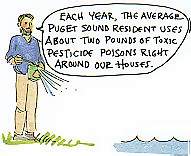In
Your Lawn and Garden
For years,
pest control has meant chemicals. Once viewed as safe and effective
for insect control, chemical pesticides are now recognized as
having potential for ecological harm; poisoning wildlife, contaminating
water and the soil itself, and harming humans – especially children.
Some of this
poison finds its way into Puget Sound where it disrupts the balance
of life. Many pesticides last a long time. When they enter Puget
Sound, they can move from place to place causing problems all
along the way.


Taking
Action
Integrated
Pest Management (IPM) is a horticultural practice that focuses
on prevention by considering the ecosystem as a whole. An IPM
approach to lawn and garden maintenance begins with an understanding
of the physical conditions the plants require to thrive. IPM prevents
pest problems by using appropriate, adapted plant varieties, providing
the necessary nutrients and moisture, and following through with
good maintenance practices. Even so, problems may still arise.
An important part of IPM is defining what constitutes a problem.
We must determine the threshold level of weeds or insect damage
we are willing to accept. Setting our pest tolerance too low results
in unnecessary treatments and possible environmental damage.
 WSU
Cooperative Extension agents and publications can help provide
the needed information. Then a projection of the pest’s potential
as a problem can be determined. Often natural predators may keep
pest populations manageable over the long term, despite brief
fluctuations at certain times of the year.
WSU
Cooperative Extension agents and publications can help provide
the needed information. Then a projection of the pest’s potential
as a problem can be determined. Often natural predators may keep
pest populations manageable over the long term, despite brief
fluctuations at certain times of the year.
When
considering a treatment, the goal is not to eradicate the pest,
but to use the least toxic treatment that will drop the pest level
below our established threshold. For example, increasing nutrient
levels through fertilization might be an appropriate treatment
to allow the lawn successfully compete against a weed or insect.
Hand weeding can an appropriate response in some situations.
All
treatments need to be evaluated periodically to determine effectiveness.
The evaluation may indicate that the treatment be repeated or
changed. Often it is necessary to combine a series of treatments
to achieve a reduction of pest levels.
Although
it may sound pretty technical, applying the IPM method to home
garden and lawn care is not difficult. With a little determination
to learn about horticultural practices and pest life cycles, we
can minimize chemical use without compromising the aesthetic quality
of our landscapes.




